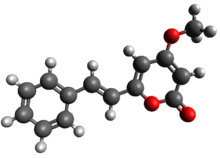
| |

| |
| Names | |
|---|---|
| Preferred IUPAC name 4-Methoxy-6--2H-pyran-2-one | |
| Other names
(E)-4-Methoxy-6-styryl-2H-pyran-2-one 5,6-Dehydrokavain 4-Methoxy-6--2-pyranone | |
| Identifiers | |
| CAS Number | |
| 3D model (JSmol) | |
| ChEMBL | |
| ChemSpider | |
| PubChem CID | |
| UNII | |
| CompTox Dashboard (EPA) | |
InChI
| |
SMILES
| |
| Properties | |
| Chemical formula | C14H12O3 |
| Molar mass | 228.247 g·mol |
| Appearance | white to faint yellow powder |
| Density | 1.18 g/mL |
| Melting point | 148 °C (298 °F; 421 K) |
| Boiling point | 440 °C (824 °F; 713 K) |
| Except where otherwise noted, data are given for materials in their standard state (at 25 °C , 100 kPa).
| |
Desmethoxyyangonin or 5,6-dehydrokavain is one of the six main kavalactones found in the Piper methysticum (kava) plant.
Pharmacology
Desmethoxyyangonin is a reversible inhibitor of monoamine oxidase B (MAO-B). Kava is able to increase dopamine levels in the nucleus accumbens and desmethoxyyangonin likely contributes to this effect. This, along with several other catecholamines, may be responsible for the purported attention-promoting effects of kava.
Unlike the other major kavalactones, desmethoxyyangonin does not appear to act as a GABAA receptor positive allosteric modulator.
Desmethoxyyangonin has marked activity on the induction of CYP3A23.
See also
References
- Uebelhack, R; Franke L; Schewe HL (September 1998). "Inhibition of platelet MAO-B by kava pyrone-enriched extract from Piper methysticum Forster (kava-kava)". Pharmacopsychiatry. 31 (5): 187–192. doi:10.1055/s-2007-979325. PMID 9832350. S2CID 25270815.
- Baum, SS; Hill R; Rommelspacher H (October 1998). "Effect of kava extract and individual kavapyrones on neurotransmitter levels in the nucleus accumbens of rats". Progress in Neuro-Psychopharmacology and Biological Psychiatry. 22 (7): 1105–1120. doi:10.1016/S0278-5846(98)00062-1. PMID 9829291. S2CID 24377397.
- Boonen, G.; Häberlein, H. (1998). "Influence of genuine kavapyrone enantiomers on the GABA-A binding site". Planta Medica. 64 (6): 504–506. doi:10.1055/s-2006-957502. PMID 9776662. S2CID 45511040.
- Ma, Yuzhong; Karuna Sachdeva; Jirong Liu1; Michael Ford; Dongfang Yang; Ikhlas Khan; Clinton Chichester; Bingfang Yan (November 2004). "Desmethoxyyangonin and dihydromethysticin are two major pharmacological kavalactones with marked activity on the induction of CYP3A23". Drug Metabolism and Disposition. 32 (11): 1317–1324. doi:10.1124/dmd.104.000786. PMID 15282211. S2CID 43840844.
{{cite journal}}: CS1 maint: numeric names: authors list (link)
| Kava | |||||||
|---|---|---|---|---|---|---|---|
| History | |||||||
| Chemical composition |
| ||||||